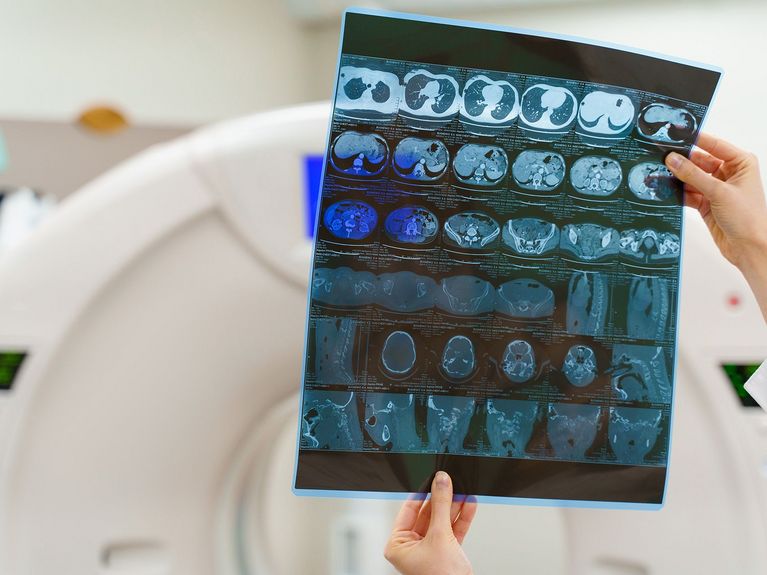UroBot
How AI chatbots could change medicine

Picture: Rabizo Anatolii/shutterstock
The newly developed “UroBot” is familiar with all guidelines and consensus papers on oncological diseases in urology. Once it has been fed patient data, it provides accurate therapy recommendations – a development that could permanently change cancer medicine.
The inspiration for the programme that could change cancer treatment forever came to Titus Brinker in December 2023, just before he went to a Christmas party. He was a little early, so he turned on the TV news and saw the ChatGPT programme - represented by an animated character, an avatar - demonstrating its conversational skills. This could be a huge opportunity for patient care, thought Brinker, an oncologist and IT specialist at the German Cancer Research Centre (DKFZ) in Heidelberg. So he told his colleagues about it at the party. They were enthusiastic. And the thought became an idea that would not go away. Soon after, Brinker was involved in a collaboration between the DKFZ and doctors at the University Hospital of Urology in Mannheim. And they began developing two chatbots at the same time: one for patients and one for urologists to exchange information. And it could serve as a model for a lasting change in medical care.
Progress is fantastic - but it can also be confusing. In cancer treatment - for urological tumours as well as others, from bronchial carcinoma to breast cancer - new discoveries are being made at an ever-increasing pace that could mean better treatment for certain patients. To keep the guidelines up to date, they need to be updated more frequently. These are called "living guidelines", which are updated at shorter intervals. This is good news, but for doctors, even if they work in a tumour centre, it means that it is becoming increasingly difficult to keep up to date.
Titus Brinker is Head of the Division of Digital prevention, diagnostics and therapy guidance at the German Cancer Research Center (DKFZ). Bild: Titus Brinker
“Timeliness is only one aspect of this. Many therapies are preceded by a molecular analysis of the tumor in order to find ideal targets for treatment. And there are more and more such targets, and the therapies are becoming more and more specific and individualized. This in turn means that there are an increasing number of treatment options that an oncologist needs to be aware of,” says Brinker.
This is exactly what the 'UroBot-4o', or UroBot for short, developed by Brinker and his team is designed to do. To do this, they fed Open AI's powerful GPT-4o language model with PDFs of all kinds of guidelines and scientific publications. We taught the program to extract and process all the information from the text, figures, tables and graphics in the many thousands of pages of PDFs," says Brinker. To keep UroBot up to date, Brinker and his colleagues have written a program that regularly searches the Internet for new documents and guideline updates.
And it really works: if you feed UroBot all the data on a patient with bladder cancer, including the molecular analysis of the tumour, it processes the data, compares it with all the content it has learned from the PDFs and provides a therapy recommendation within seconds. Perhaps the most important thing that makes UroBot really make a difference is a feature that Brinker has built into the way the data is created and output: We have trained UroBot to provide evidence for every answer it gives," says Brinker.
This is the big difference to the well-known ChatGPT programme. While ChatGPT often hallucinates and cannot back up its statements, UroBot's answers have footnotes after almost every sentence - if you click on them, you are taken directly to the place in the corresponding PDF where the statement was derived. Of course, UroBot is completely emotionless and can't do many of the things a doctor can. But it can probably process data more accurately than any human, compare it with known knowledge and make recommendations based on that,' says Brinker, with a hint of pride in his voice.
Brinker and his team have already tested how good UroBot is: in the specialist urology examination. The result was convincing: with 88.4% correct answers, the UroBot performed better than the average performance of urologists, which is 68.7%. In a three-arm study, Brinker and his team are currently investigating whether the UroBot can actually make better decisions than a doctor on complex oncological issues based on individual patient data. They are comparing the following treatment decisions: First, those made by several doctors in so-called tumour boards; second, those made jointly by UroBot and doctors; and third, those made by UroBot alone. If it turns out that UroBot makes the best decisions, this could lead to a small revolution," says Brinker.
It would mean that UroBot itself is a kind of highly efficient tumour board. For doctors, this would be an enormous help in making the right treatment decisions. However, it will be some time before this happens: "In the European Union, it takes six to eight years for a medical device to be approved. And the UroBot and our further development, the CancerBot, would be classified as medical devices. Of course, we hope that this process will be accelerated in view of the enormous benefits," says Brinker.
CancerBot is a patient-focused chatbot designed to answer not only urological questions, but all cancer-related questions. CancerBot is not only good at processing information, it can also communicate information in an understandable way. This can be a great help for patients who want to better understand their treatment or prepare for a doctor's appointment," says Brinker. The Cancer Information Service will soon offer interested patients the opportunity to use CancerBot. Initially, however, it will only be available as part of studies evaluating the advice provided by CancerBot. The ethics application has already been approved and the service is expected to be launched in early 2025.
Readers comments